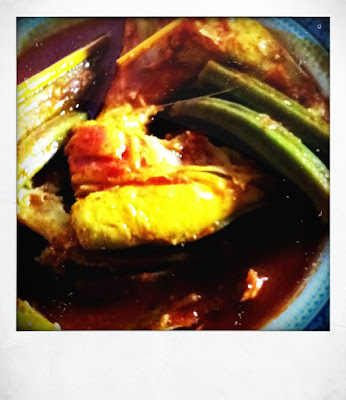 |
| delimilli's Seafood Paella |
The first time I laid eyes on a pan of paella; I knew it was love at first sight. My thoughts were that it was such a smart dish - everything in a pan; served hot and shared; it seemed to be the perfect meal to have with friends and loved ones. I ate my first paella in Madrid during my first backpacking trip across Europe with my friend Cindy some 13years ago. (I won first prize at a company function; winning 2 standby tickets on Lufthansa - for my very first trip to Europe!) I remember the first 2 occasions eating this dish; once at a little restaurant in downtown Madrid; a few blocks away from El Prado and the other in a little canteen at the railway station in a small town in Spain. I cannot remember the town's name, all I recall was that it was such a treat, given our tight budgets. Everything tastes more delicious it seems, when it is scarce! Fast forward time; I have eaten many versions of the seafood paella - in Spain; mostly in Madrid and here in the United States. It became one of my favorite Spanish dishes ever. With warm memories of the Spanish paella in mind, I requested Connie to recreate it. I knew that she was more than capable of re-creating that delicious, seafood flavor from scratch. True to expectations, Connie definitely did not dissapoint. Her attention to detail is unparalleled, and the end result of the 2 hour toil was utmost deliciousness in a pan - perfectly seasoned, wonderful aroma, rich (almost like a lobster bisque). I certainly was not disappointed. - Ros
...Paella... It took me some time to understand why 'Paella' was Spain's national dish, and even longer time to experience first hand a dish that I would always remember! I don't recall when was the first time I tried paella. Perhaps, during my childhood in Latin America, all the paellas I had were just rice stews, attempting to be paella, but not truly well rendered. It took some time for me to meet true Paella face to face. My most memorable one was actually in a very typical Spanish restaurant in Madrid, Barrio Salamanca. After a long project working to launch Xfera, one of the first bidders for 3G in Europe, a new colleague and I went to celebrate the end of the project and my return to the US after months of commuting from Madrid to Chicago. That Paella holds special memories for me and since then, I've been capitalizing Paella, whenever I write about it... For the first time, the Paella had a golden hue, made with saffron (and not tumeric, or other yellow spice), and the ingredients in it were beautifully fresh and captivating celebrating the bounty of land and sea. I recall eating mounds of it and being delighted, as though befriending someone I had known for the first time - this time getting to know it in so much more detail. It's been many years since that Paella changing experience, and my colleague (now friend) and I still keep in touch with the wonders of Facebook. Nowadays, in Chicago, I've discovered that Cafe Iberico and Cafe Ba Ba Re Ba, offer amazing types of Paellas and my favorite is the one that uses octopus ink! When Ros asked me to re-create a Paella for her, I was a bit hesitant, not knowing if I could meet my old friend (true Paella) eye to eye. Nevertheless, I ventured on this journey and albeit intimidating it has been a fun experience and we ended up with a dish we absolutely loved! Now, Paella pan in hand, I want to try other flavors, perhaps one of these days even do it outdoors in a grill, and maybe in the future - create a fusion Asian Paella! It is truly, one of the few dishes that brings to a highlight every single one of its ingredients. We hope you enjoy this as we did! - Connie
Ingredients
Serves 6
Inspired by Mario Batali's "Spain A Culinary Road Trip" recipe from Valencia - with a twist
- 1/2 cup extra virgin olive oil
- 6 large prawns (we recommend using prawns with heads in the shell if possible)
- 1 medium Spanish onion into 1/4" dice
- 1/2 tomato puree
- 1 tsp kosher salt
- 1 tsp saffron threads (please do not substitute if possible! Using saffron is all worth it!)
- 1 tbs sweet pimento (you can also use "pimenton picante" which gives it a zing)
- 1 lb cuttlefish cut into 1" slices (you can substitute it with squid)
- 2 quarts of fish stock (this can be made from scratch with fishbones and water - or if you buy pre-made stock - we recommend using 25 - 50% stock and the rest water)
- 2 cups bomba rice
- 1 lb lobster tail cut lengthwise (original recipe called for monkfish, but we love lobster, so voila!)
- 1lb little neck clams (original recipe calls for manila clams, which are much smaller, but use any small clam you can have - they are fabulous)
Process
Heat 14" paella pan over medium high heat. Add the oil and heat until smoking. Add the prawns and lobster tails, cook until golden brown on both sides (about 2 - 3 mins per side). Transfer to a plate and set aside.
 |
| Pan frying the lobster tails in extra virgin olive oil |
Add the onion to the pan and cook until soft for 5 - 8 minutes.
 |
| Panfrying Diced Yellow Onion in Extra Virgin Olive Oil |
Add the tomato puree, stirring it into the pan. Cook for 3 minutes. Add the salt, pimenton, saffron and cuttlefish (or squid) and cook stirring for 5 minutes or until the cuttlefish firms up slightly.
 |
| Cuttlefish Cooked With Pimento, Saffron, and the Onion. |
Add the stock and bring to a boil. Cook for five minutes.
 |
| Fish Stock Added to the Mix, Allowed to Boil |
Add the rice and stir well to distribute it evenly.
 |
| Bomba Rice Was Added to the Boiling Stock |
Add the lobster tails and clams, arranging them nicely. Bring the stock back to a boil and cook without stirring for 10 minutes (* If it overflows, set aside a bit of the boiling liquid and let it boil and when possible (in the next 5 - 8 mins) add back the liquid that was set aside).
KEY: Do not stir.
 |
| Lobster Tail, Shrimp, Clams Were Added Last |
Add the prawns, taste for salt and cook again without stirring, for 10 - 15 more minutes or until the liquid is almost completely absorbed and the pan starts making a crackling sound.
 |
| The Ingredients In The Pan Were Allowed to Cook |
Remove from heat and let it rest for 10 minutes before serving. Enjoy! Perfect for sharing with family and friends and if you would like to pair it with wine, it goes perfectly well with a chilled Albarino (I recommend Condes de Albarei, one of my favorites!) Enjoy every single bite!
As an extra recommendation - the soccarat (the slightly toasted rice in the bottom) can be eaten mixed with the Paella or after eating the top!). It is the best part. ...Chinese people also do something similar with the bottom crusty rice left after fried rice - but that is a story for another occasion.
 |
| The Fish Stock Disappeared as The Rice Was Cooked |
























